Table Of Content
- Understanding Snowstorms and Winter Camping Dangers
- What Makes Snowstorms So Dangerous?
- Essential Winter Camping Gear for Snowstorm Preparedness
- Snowstorm Tips for Winter Survival
- Essential Winter Camping Gear for Snowstorm Preparedness
- Clothing
- Footwear
- Shelter
- Tools
- Navigation Tips During Snowstorms
- Trust Your Compass
- Identify Landmarks
- Follow Your Tracks
- Stay Calm and Assess Your Surroundings
- Snow Shelter Building Techniques for Winter Survival
- Gather Necessary Tools and Materials
- Choosing the Right Location
- Building the Snow Shelter
- Adding Finishing Touches
- First Aid and Emergency Response in Snowstorm Conditions
- Stay Prepared with a Comprehensive First Aid Kit
- Know How to Identify and Treat Hypothermia and Frostbite
- Establish Clear Communication and Emergency Protocols
- Practice Self-Rescue Techniques
- Food and Water Management in Winter Camping
- Quality Over Quantity
- Hydration Is Key
- Signs of Hypothermia and Frostbite to Watch For
- Symptoms of Hypothermia
- Indications of Frostbite
- Communication Strategies in Snowstorm Scenarios
- Stay Connected
- Emergency Signals
- Establish Rally Points
- Fire Starting and Maintenance in Cold Weather
- Tips for Fire Starting
- Maintaining Your Fire
- Importance of Fire in Winter Survival
- Staying Calm and Focused During Snowstorms
- Remaining Steady Amidst the Frozen Chaos
- Embracing the Blizzard Zen
- Guided by the Light Within
- Frequently Asked Questions (FAQs)
- What are some essential tips for handling snowstorms during winter camping?
- How can one ensure winter camping safety during a snowstorm?
- What should one do if caught unexpectedly in a snowstorm while camping?
- Are there specific snowstorm tips for winter survival?
- What gear is essential for handling snowstorms while winter camping?
- Should one venture out during a snowstorm while winter camping?
Welcome, winter adventurers! As seasoned campers and outdoor enthusiasts, we know the thrill and excitement that come with winter camping. However, we must always remember that with the beauty of winter landscapes also comes the potential danger of snowstorms. Handling snowstorms during winter camping requires knowledge, preparation, and quick thinking to ensure your safety and survival.
Winter camping safety is paramount when it comes to braving the elements in colder months. Snowstorms can be unpredictable and harsh, making it crucial to be equipped with the right skills and gear to navigate through them. In this guide, we’ll dive into essential snowstorm tips and winter survival techniques to help you stay safe and enjoy your outdoor winter adventures to the fullest.
When facing snowstorms during winter camping, preparation is key. From packing the right clothing layers to understanding how to navigate through whiteouts, being ready for challenging weather conditions can make all the difference. Stay tuned as we share valuable insights and expert advice on how to handle snowstorms and ensure your winter camping experience is not only thrilling but safe.
Join us on this journey as we delve into the essential winter camping safety tips, snowstorm handling techniques, and winter survival strategies. Let’s embrace the winter wonderland while prioritizing our safety and well-being in the great outdoors. Together, we’ll conquer the snow-covered landscapes and create unforgettable memories under the crisp winter skies.
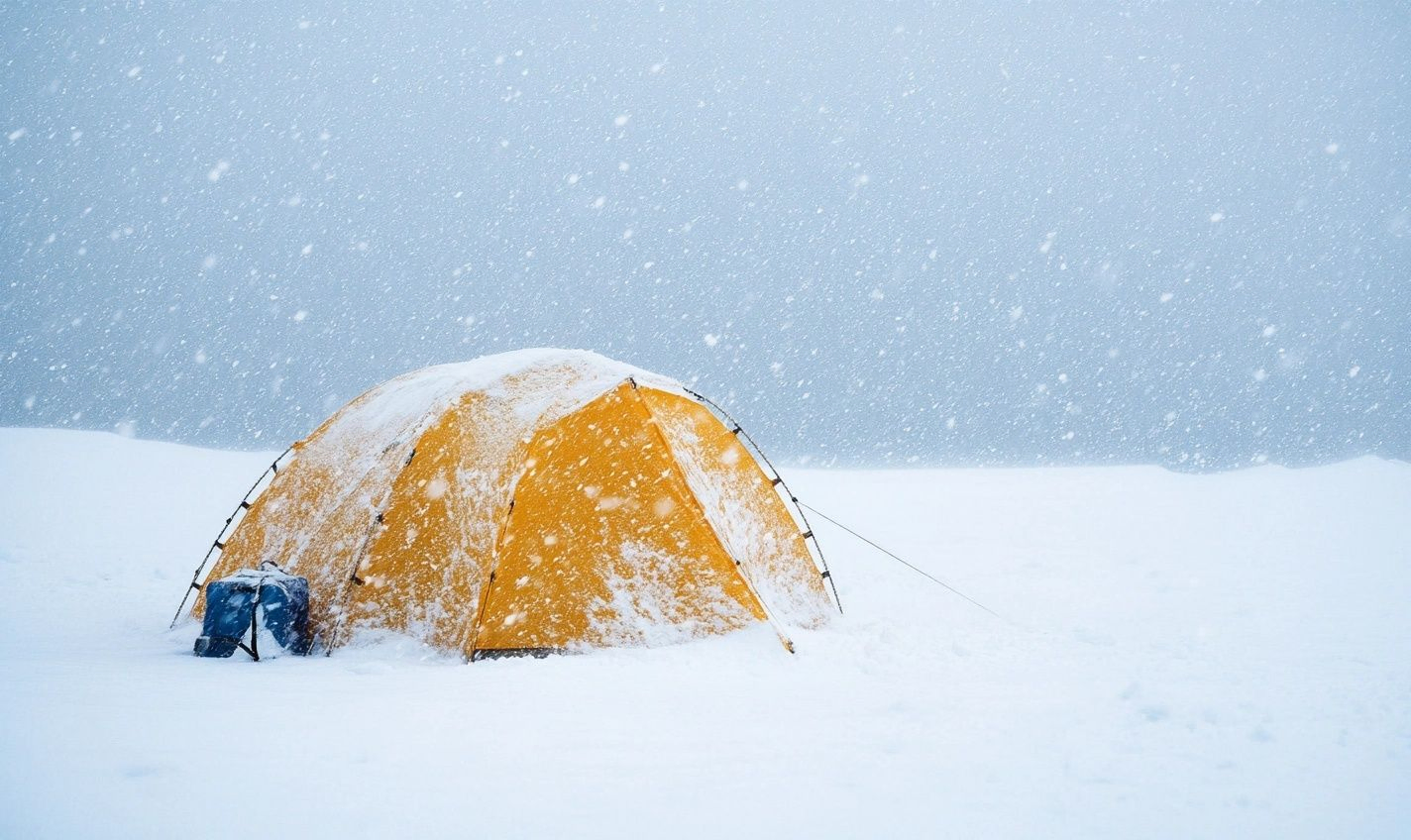
Understanding Snowstorms and Winter Camping Dangers
A thick blanket of snow covering the ground, the serene beauty of a winter wonderland, a crackling fire in the cold – winter camping can be a magical experience. But, amidst this enchanting landscape lies a hidden danger – snowstorms.
What Makes Snowstorms So Dangerous?
- Rapidly Changing Conditions: Snowstorms can hit unexpectedly, turning a peaceful camping trip into a survival situation.
- Extreme Cold: Subzero temperatures during snowstorms pose a serious risk of frostbite and hypothermia.
- Reduced Visibility: Blinding snowfall can make it challenging to navigate and find your way back to safety.
Essential Winter Camping Gear for Snowstorm Preparedness
- Insulated layers to keep you warm and dry.
- Emergency shelter, such as a tent or bivvy sack.
- Navigation tools like a map, compass, and GPS.
Imagine being caught in a snowstorm without the right gear – it could mean the difference between a cozy night by the fire and a fight for survival.
Snowstorm Tips for Winter Survival
- Stay Put: If a snowstorm hits, find shelter and stay there until conditions improve.
- Keep Hydrated: Drink plenty of water to prevent dehydration, even in cold weather.
- Build a Snow Shelter: Digging a snow cave or building a snow trench can provide insulation from the cold.
Remember, in the face of a snowstorm, your preparedness and quick thinking are your best allies. Stay informed, stay calm, and stay safe.

Essential Winter Camping Gear for Snowstorm Preparedness
When venturing into the winter wilderness, being prepared for snowstorms is crucial for your safety and survival. The right gear can make all the difference between a challenging experience and a life-threatening situation. Here’s a list of essential winter camping gear to help you prepare for unexpected snowstorms:
Clothing:
- Insulated, waterproof layers to protect against the cold and wet.
- Thermal underwear and moisture-wicking socks to keep you warm and dry.
- Windproof and waterproof outerwear like jackets and pants.
Footwear:
- Sturdy, insulated boots with good traction for walking in snow and ice.
- Gaiters to keep snow out of your boots and protect your lower legs.
Shelter:
Having the right shelter is crucial during a snowstorm. Make sure to bring:
- A four-season tent that can withstand heavy snowfall.
- An emergency bivy or space blanket for added warmth.
Tools:
Carrying the right tools can help you navigate through a snowstorm and stay safe:
- A sturdy shovel for digging out a snow shelter or clearing snow.
- An ice axe for added grip and stability on icy terrain.
Remember, proper preparation is key to winter survival. Pack smart, dress warmly, and stay alert to snowstorm signs. With the right gear and knowledge, you can brave the winter wilderness and come back safely!
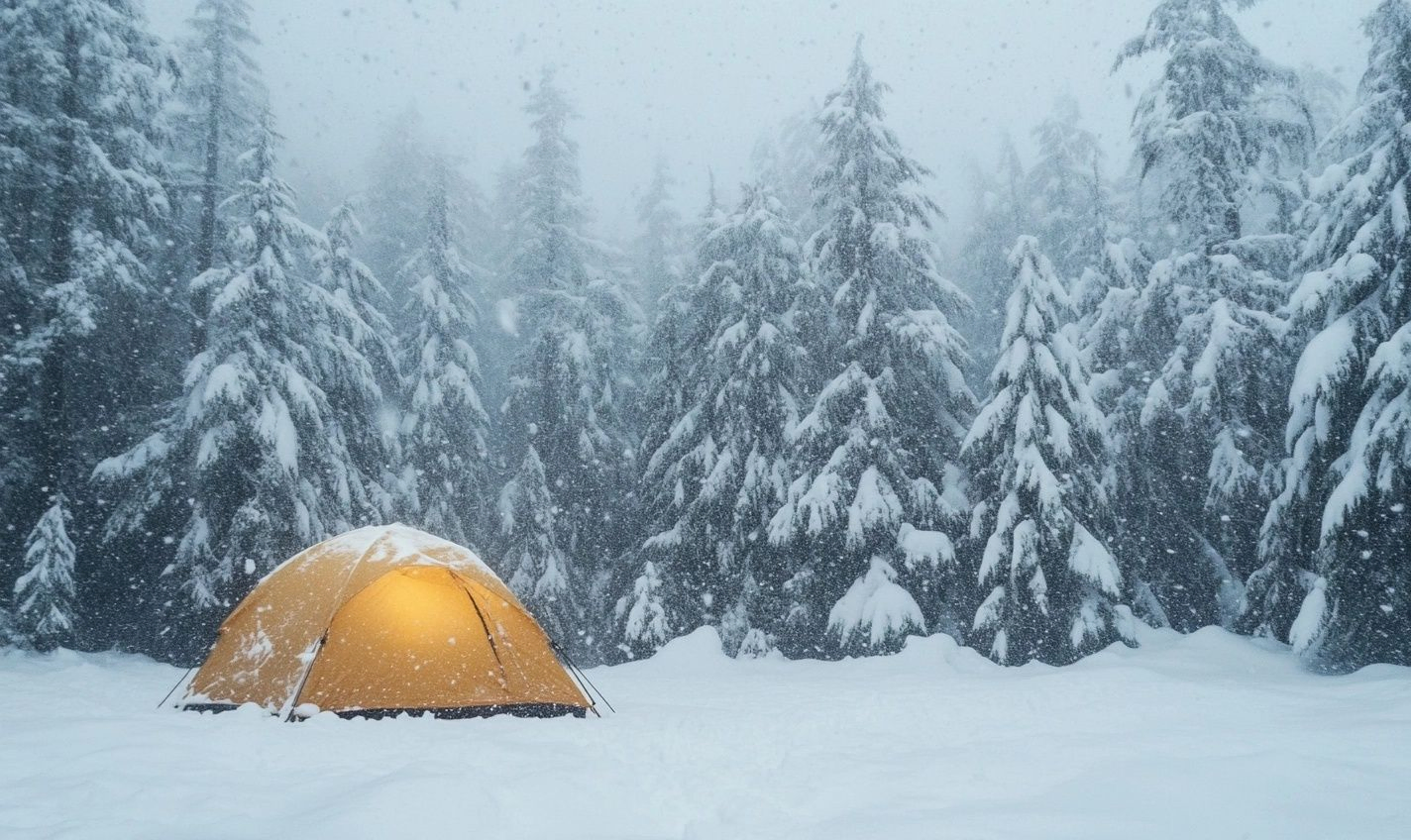
Navigation Tips During Snowstorms
When you find yourself in the midst of a snowstorm during a winter camping trip, navigation becomes a crucial skill for your survival. The whiteout conditions and limited visibility can easily disorient even the most experienced campers. Here are some tips to help you navigate safely through a snowstorm:
Trust Your Compass
Your compass is your best friend in a snowstorm. Make sure you know how to use it properly before heading out on your adventure. Keep it easily accessible, and check it frequently to stay on the right track.
Identify Landmarks
Look for landmarks such as distinctive trees, rocks, or terrain features that you can use as reference points. These landmarks can guide you in the right direction and prevent you from getting lost in the swirling snow.
Follow Your Tracks
If you ventured out from a campsite or a familiar location, try to follow your own tracks back if the snowstorm picks up suddenly. This can lead you safely back to where you started without wandering aimlessly.
Stay Calm and Assess Your Surroundings
Panicking can cloud your judgment and lead to poor decision-making. Take a moment to breathe, assess your surroundings, and determine the best course of action. Clear thinking is crucial in navigating a snowstorm.
Remember, winter camping in snowstorms requires extra caution and preparedness. By following these navigation tips, you can increase your chances of staying safe and finding your way back to camp unharmed.

Snow Shelter Building Techniques for Winter Survival
When caught in a snowstorm during a winter camping trip, knowing how to build a snow shelter can be a crucial skill for surviving the harsh conditions. Let’s explore some effective snow shelter building techniques to help you stay safe and warm despite the freezing temperatures.
Gather Necessary Tools and Materials
Before starting to build your snow shelter, ensure you have the following tools and materials:
- Shovel or snow saw
- Compact snow for building
- Thermos for hot drinks
Choosing the Right Location
When selecting a spot for your snow shelter, consider the following factors:
- Flat terrain away from potential avalanche zones
- Close to available natural resources like wood for fire
Building the Snow Shelter
Follow these steps to construct a sturdy and well-insulated snow shelter:
- Begin by piling up snow to create a mound
- Let the snow settle for a while before digging out the interior
- Create a small entrance to prevent heat loss
Adding Finishing Touches
Once the basic structure of your snow shelter is complete, consider the following enhancements:
- Line the interior with pine branches for extra insulation
- Place a tarp or emergency blanket inside for added warmth
Remember, a well-built snow shelter can make all the difference when facing the challenges of a snowstorm during winter camping. Ensure you practice these techniques beforehand to be prepared for any unexpected situations. Stay safe and enjoy the snowy outdoors!
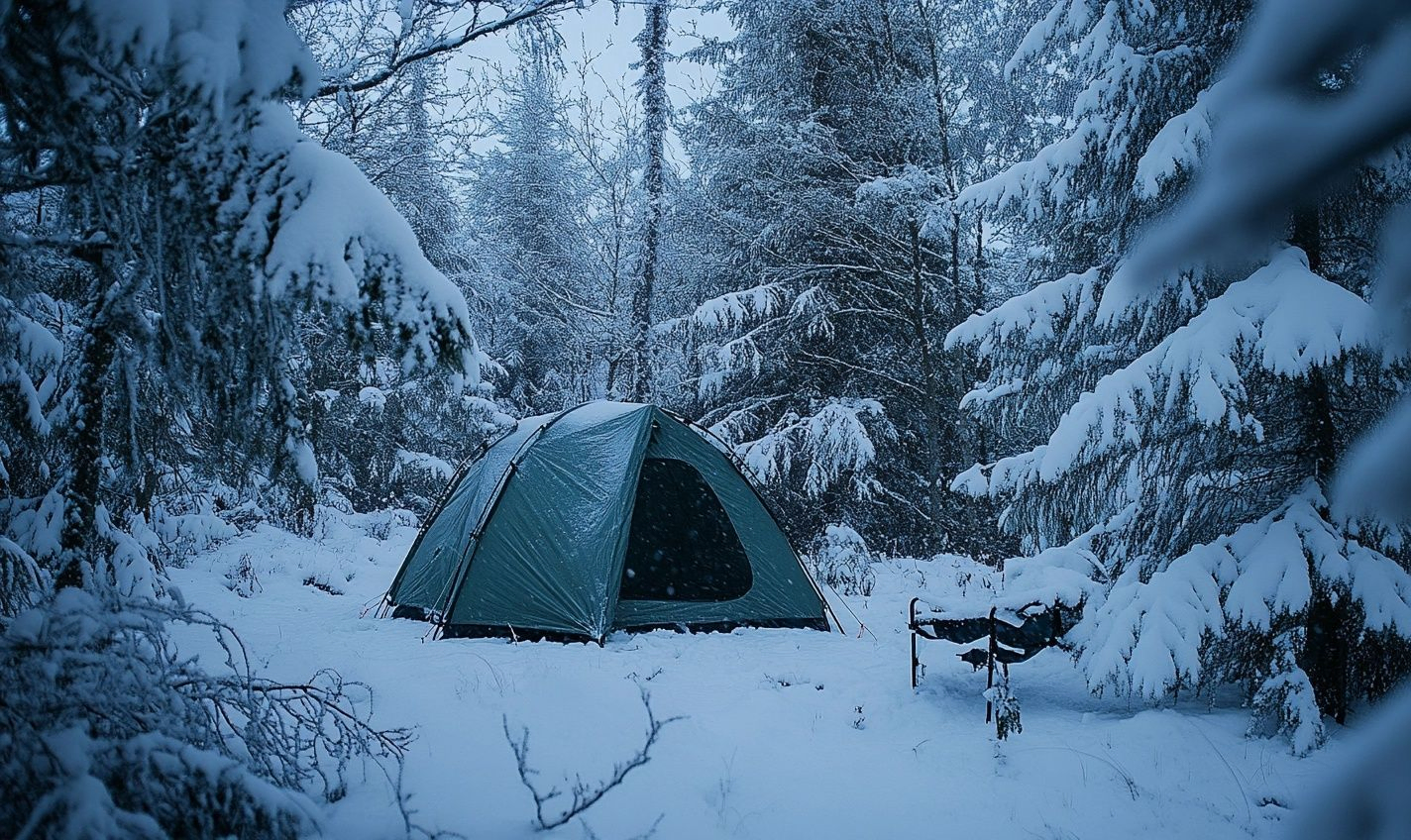
First Aid and Emergency Response in Snowstorm Conditions
When facing the harsh reality of handling snowstorms during a winter camping expedition, understanding how to tend to injuries and emergencies is crucial for ensuring the safety and well-being of everyone in your group. Here are some essential tips to guide you through winter survival:
Stay Prepared with a Comprehensive First Aid Kit
Being equipped with a well-stocked first aid kit specifically tailored for cold weather conditions can make all the difference in case of emergencies. Include items such as thermal blankets, hand warmers, instant hot packs, and waterproof matches.
Know How to Identify and Treat Hypothermia and Frostbite
Recognizing the early signs of hypothermia and frostbite is vital in preventing these conditions from escalating. Be vigilant for symptoms like shivering, confusion, numbness, and pale skin. Quick action, such as rewarming affected areas gradually and seeking medical help if needed, can be life-saving.
Establish Clear Communication and Emergency Protocols
- Designate a communication plan within your group to stay connected in case of separation during a snowstorm.
- Set up emergency signals, such as whistle blasts or light patterns, to indicate distress and summon help.
Practice Self-Rescue Techniques
- Learn how to construct emergency shelters using available resources like snow caves or debris huts.
- Understand how to start and maintain a fire for warmth and signaling purposes.
Remember, your ability to stay calm and focused amidst a snowstorm can be your greatest asset. By prioritizing safety, preparedness, and efficient emergency response strategies, you can navigate the challenges of winter camping with confidence and resilience.
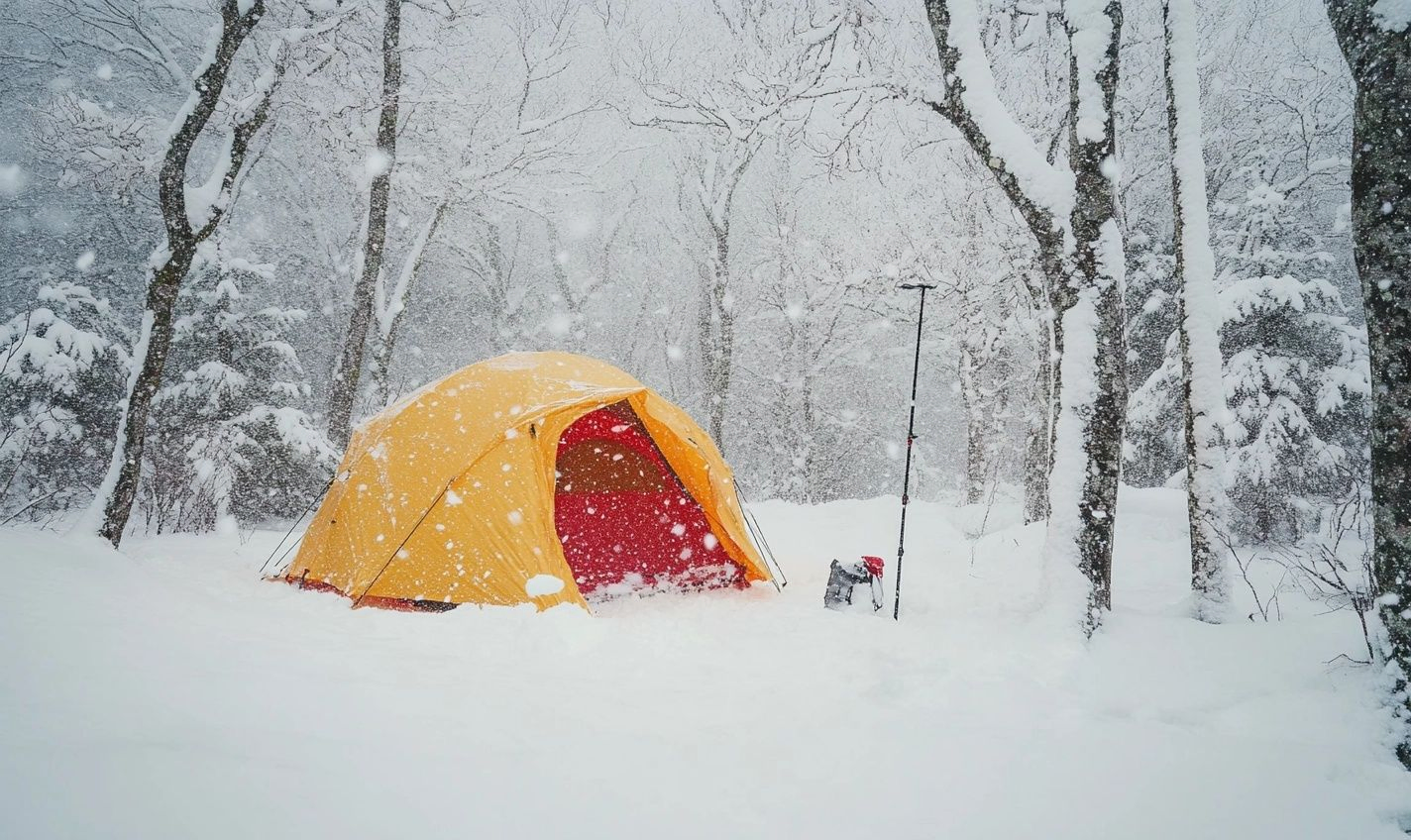
Food and Water Management in Winter Camping
When you’re out in the winter wilderness, handling snowstorms and ensuring winter camping safety become paramount. Among the essentials for winter survival, managing your food and water resources plays a crucial role in staying healthy, energized, and hydrated.
Quality Over Quantity
- Opt for nutrient-dense foods that provide essential energy and warmth.
- Pack lightweight, high-calorie snacks like nuts, dried fruits, and energy bars.
- Ensure you have a mix of carbohydrates, proteins, and fats to fuel your body efficiently.
Hydration Is Key
- Keep your water bottles insulated to prevent freezing.
- Drink water frequently, even if you don’t feel thirsty, to avoid dehydration.
- Consider bringing a thermos with warm beverages like herbal tea or soup for additional hydration and warmth.
Remember, in the midst of a snowstorm, your body works extra hard to maintain its temperature, making proper winter camping nutrition and hydration even more crucial.
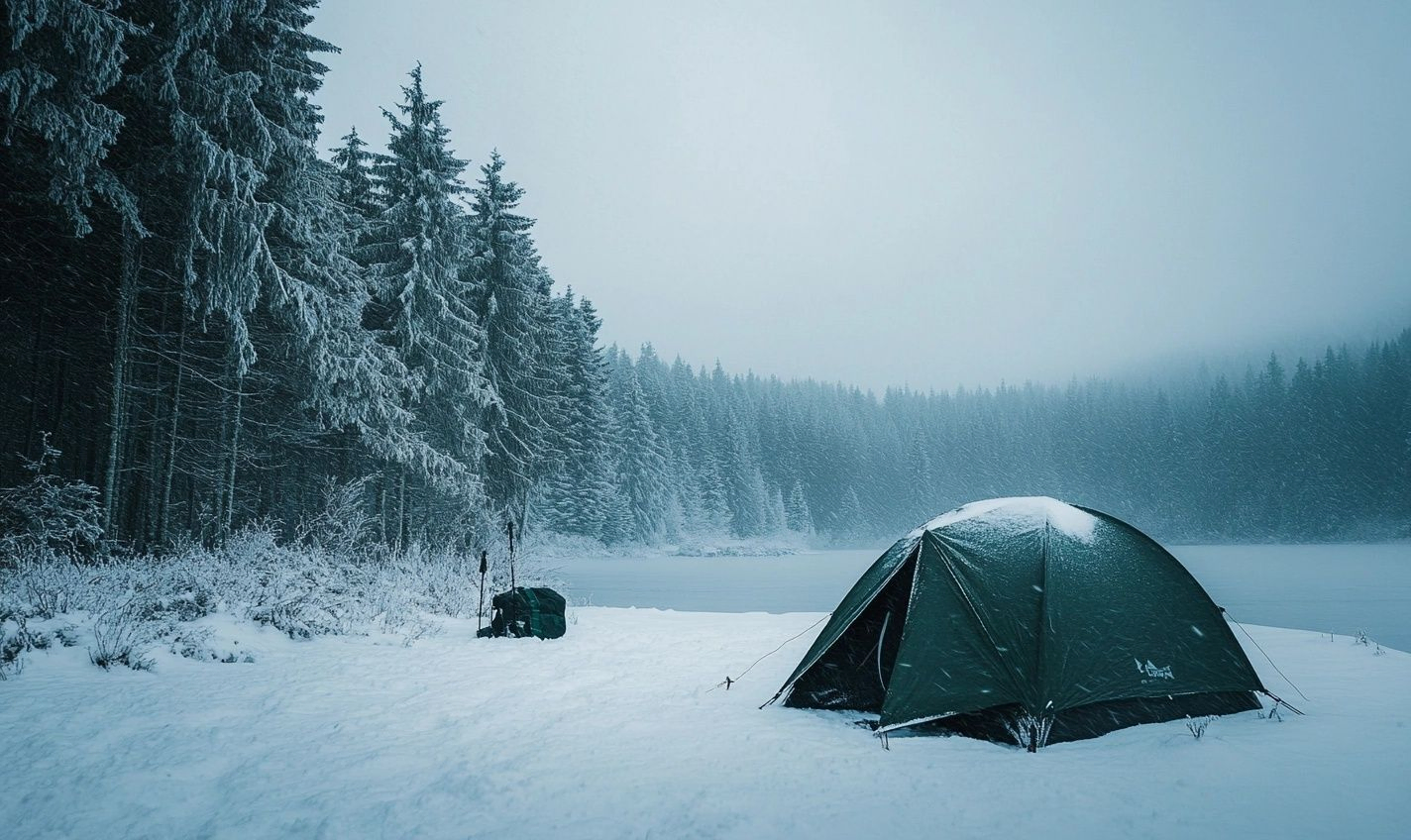
Signs of Hypothermia and Frostbite to Watch For
When braving the wilderness in the midst of a snowstorm, understanding the signs of hypothermia and frostbite is crucial for your safety and well-being. Both conditions can sneak up on you, especially in cold winter months, so it’s essential to know what to look out for.
Symptoms of Hypothermia:
Hypothermia occurs when your body loses heat faster than it can produce it, causing a dangerous drop in body temperature. Here are some signs to watch out for:
- Intense shivering
- Slurred speech
- Confusion and memory loss
- Weakened pulse and shallow breathing
Indications of Frostbite:
Frostbite is the freezing of skin and underlying tissues due to extreme cold. Recognizing these symptoms can help you act promptly to prevent further damage:
- Numbness or tingling in affected areas
- Skin that feels unusually firm or waxy
- Pale, white, or grayish-yellow skin discoloration
- Blisters or blackened skin in severe cases
Remember, prevention is key when it comes to these cold weather injuries. Dressing in warm, waterproof layers and staying dry are essential. Insulate yourself from the ground when sitting or resting to prevent heat loss. Keep an eye out for these warning signs in yourself and your camping companions. If you notice any of these symptoms, take immediate action to warm up, seek shelter, and remove any wet clothing to prevent further heat loss.
Winter camping safety is not just about the gear you pack; it’s about knowing how to react in emergency situations like snowstorms. By being prepared, vigilant, and proactive in monitoring for hypothermia and frostbite, you can enjoy your snowy adventures while staying safe and sound.
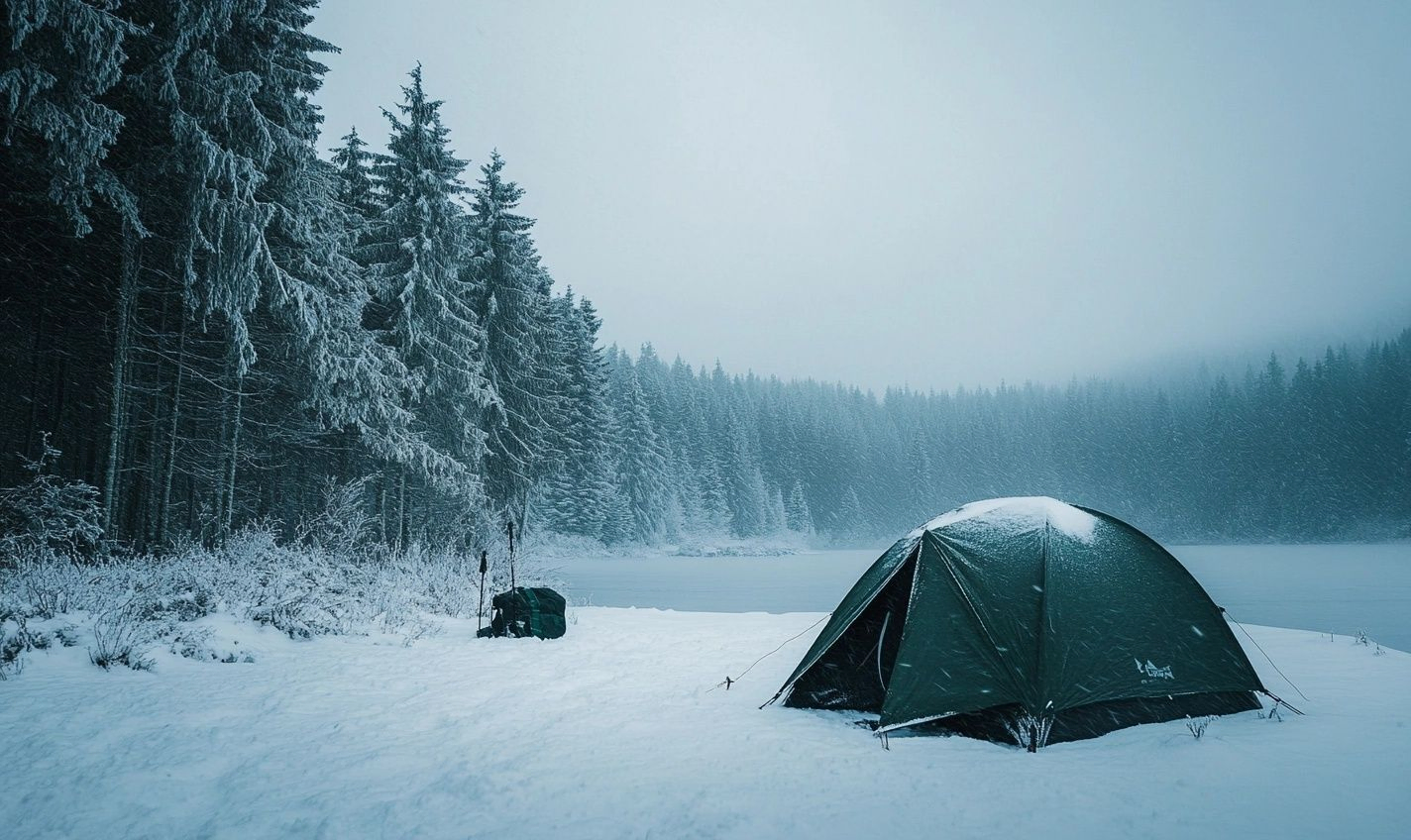
Communication Strategies in Snowstorm Scenarios
Snowstorms can be quite unpredictable and dangerous, especially when you’re out camping in the winter wilderness. However, having effective communication strategies in place can make a significant difference in your safety and survival. Let’s explore some winter camping safety tips for handling snowstorms:
Stay Connected:
Ensure you have a reliable communication device such as a satellite phone or a Personal Locator Beacon (PLB) that can work in remote areas.
Establish a check-in schedule with someone back home so they know when to expect to hear from you.
Use hand signals or whistle codes if you’re in a group to communicate in case of separation during a storm.
Emergency Signals:
Learn and memorize international distress signals such as the SOS signal (three short, three long, three short signals).
Carry signal flares, whistles, or mirrors to attract attention in case of an emergency.
Establish Rally Points:
Set up predefined meeting points with your camping group in case you get separated during a snowstorm.
Choose easily identifiable landmarks or areas with good visibility to regroup quickly.
When facing the challenges of handling snowstorms while winter camping, effective communication strategies are crucial for ensuring your safety and the safety of your companions. By staying connected, knowing emergency signals, and establishing rally points, you can better navigate through the winter wilderness and increase your chances of a successful winter camping experience. Remember, winter survival relies heavily on communication and preparedness.
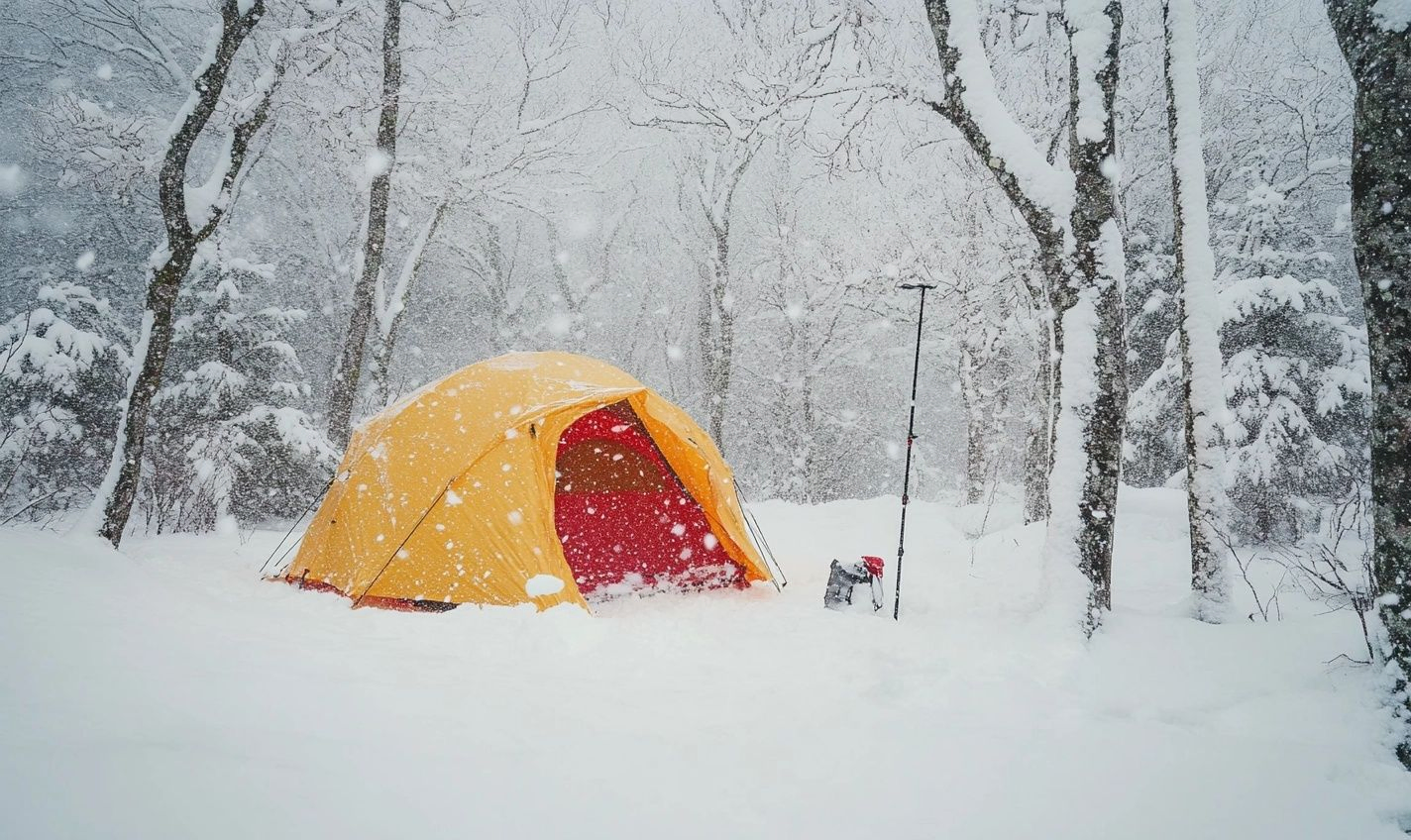
Fire Starting and Maintenance in Cold Weather
When you’re out camping in the winter, effectively starting and maintaining a fire becomes crucial for your survival. Winter camping safety heavily relies on your ability to keep warm and cook food.
Tips for Fire Starting:
Starting a fire in cold weather can be challenging but not impossible. Here are some tips to get that flame going:
- Use dry tinder, such as cotton balls soaked in petroleum jelly.
- Have a supply of dry firewood ready before lighting the fire.
- Consider using a fire starter, like a magnesium fire starter or waterproof matches.
Maintaining Your Fire:
Once your fire is going, it’s important to keep it burning steadily. Here’s how you can maintain your fire:
- Add firewood in small increments to prevent smothering the flames.
- Build a solid base using rocks or a metal grate to elevate the fire off the snowy ground.
- Keep an eye on the fire’s intensity, adjusting the size as needed to conserve fuel.
Importance of Fire in Winter Survival:
Fire does more than just provide warmth; it boosts morale and can be a signal for help. In the midst of a snowstorm, a well-kept fire can be a lifeline, signaling safety and comfort in an otherwise harsh environment.
Remember, when facing a snowstorm, the ability to start and maintain a fire is not just a skill but a lifeline to help you through the toughest of situations.
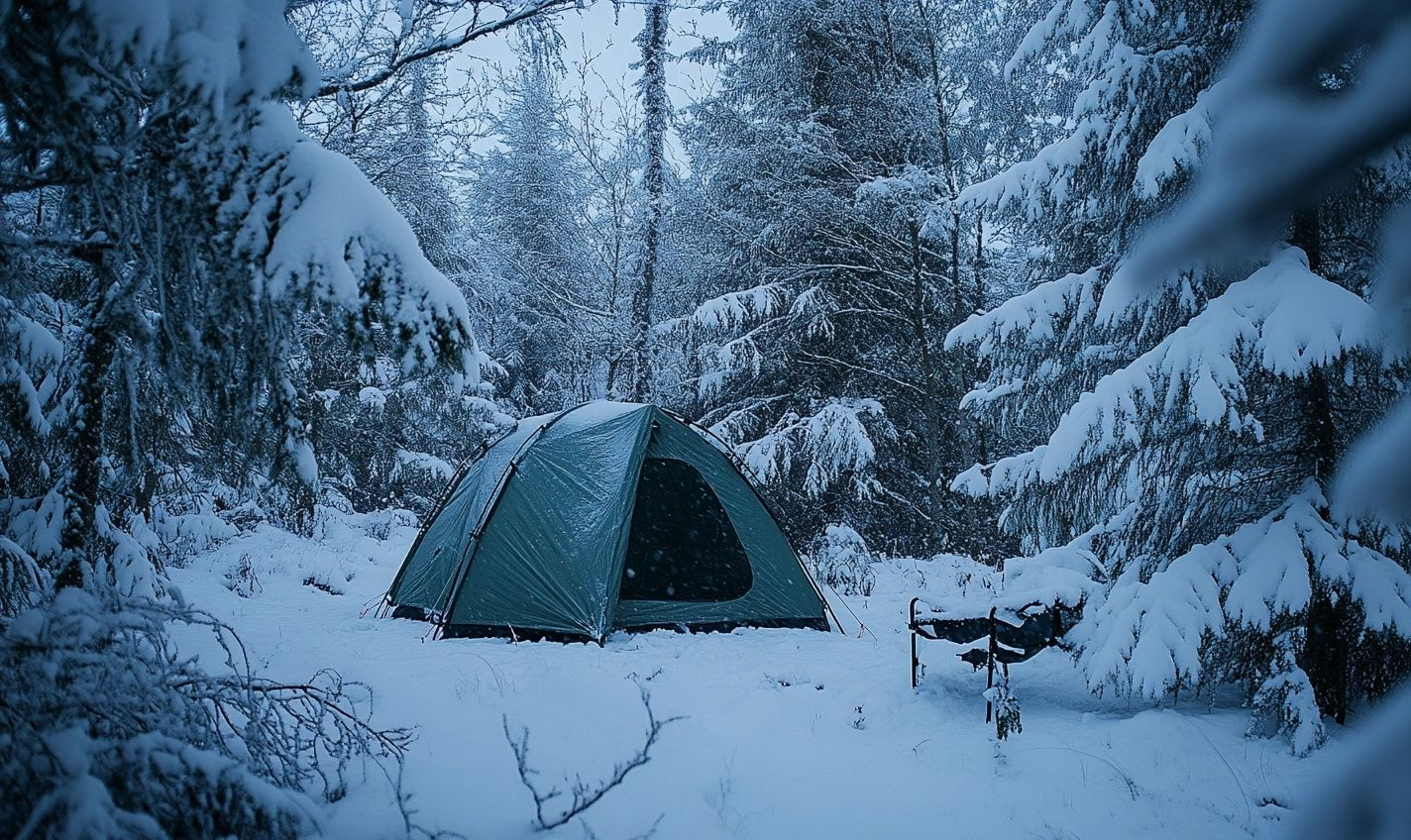
Staying Calm and Focused During Snowstorms
Remaining Steady Amidst the Frozen Chaos
When the snow starts swirling around you, the world can suddenly feel both breathtaking and perilous. Handling snowstorms while winter camping demands a unique blend of preparedness, adaptability, and above all, a calm and focused mindset.
Embracing the Blizzard Zen
Imagine yourself as a resilient tree standing amidst a blizzard. The winds may howl, and the snow may whip around you, but you remain firmly rooted in the present moment. Winter camping safety is not just about physical preparedness; it’s an exercise in mental fortitude.
Guided by the Light Within
In the midst of a snowstorm, your inner light becomes your beacon of hope. No matter how dark the clouds may be, the fire of determination within you can light the path forward. Snowstorm tips often boil down to this: find your inner strength and let it guide you through the storm.
Remember, a snowstorm is nature’s way of testing your resolve. But armed with the right knowledge and mindset, you can weather any storm that comes your way.
Conclusion
Handling snowstorms during winter camping can be challenging, but with the right knowledge and preparation, you can safely navigate through the wilderness. By following essential snowstorm tips and winter survival techniques, you can enjoy the beauty of the snowy outdoors without compromising your safety.
Remember to always check the weather forecast before heading out, pack appropriate gear such as extra layers, a reliable shelter, and sufficient food and water supplies. Understanding basic navigation skills and having a communication plan in place are crucial for emergencies.
During a snowstorm, stay calm, find shelter, and conserve your energy. Building a snow shelter, starting a fire, and signaling for help are important strategies for surviving in extreme winter conditions. Always prioritize safety over everything else.
By being well-prepared, informed, and vigilant, you can effectively handle snowstorms while winter camping and ensure a memorable and safe outdoor adventure. Stay warm, stay safe, and embrace the magical winter wonderland that awaits you!
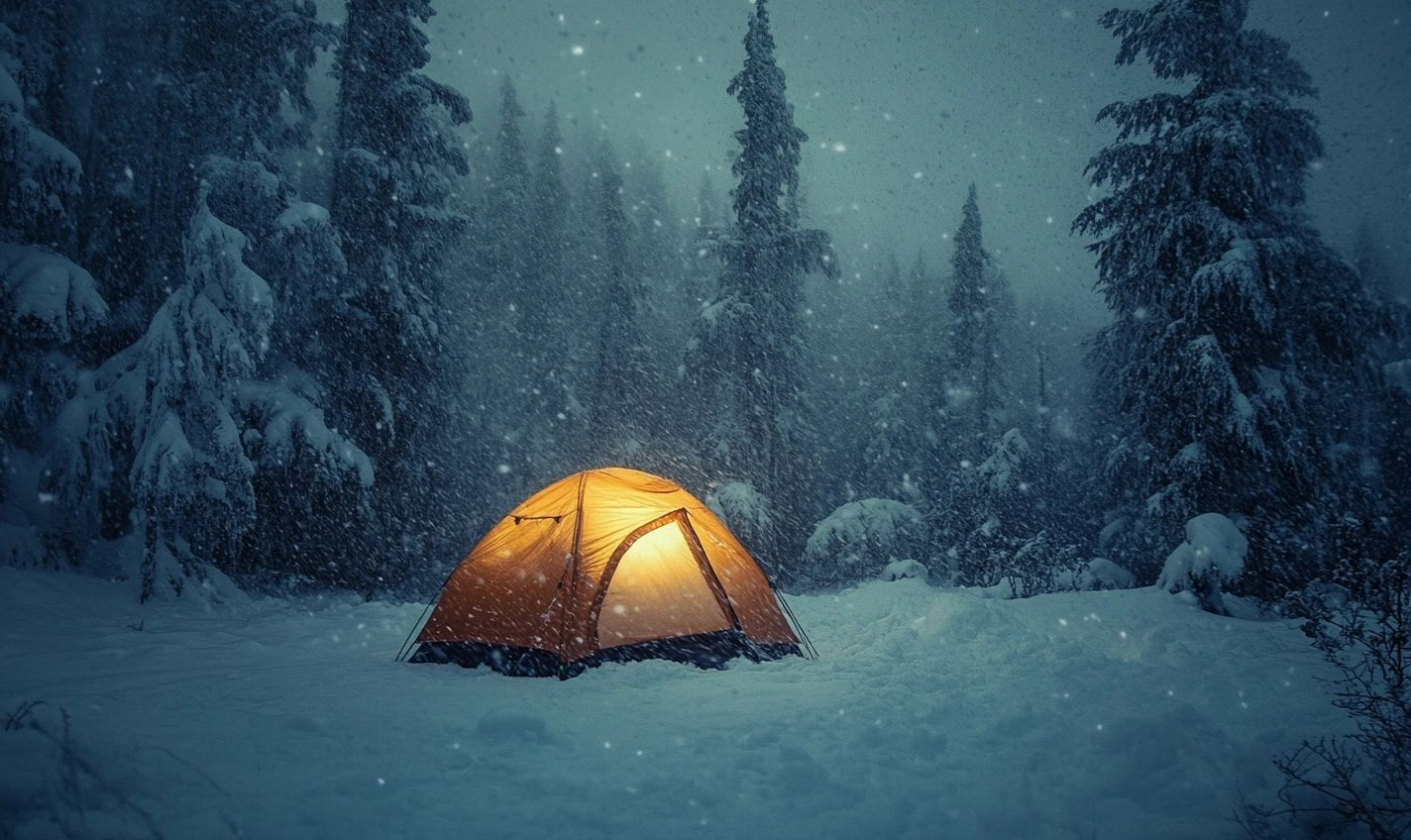
Frequently Asked Questions (FAQs)
What are some essential tips for handling snowstorms during winter camping?
When camping in winter, it is crucial to monitor weather forecasts, pack extra layers, carry a reliable GPS device, and have a well-stocked winter survival kit.
How can one ensure winter camping safety during a snowstorm?
To ensure safety during a snowstorm while winter camping, it’s important to stay dry, build a shelter, keep an emergency whistle handy, and stay close to your group.
What should one do if caught unexpectedly in a snowstorm while camping?
If caught unexpectedly in a snowstorm while camping, find or build a shelter, insulate yourself from the cold ground, and signal for help if needed.
Are there specific snowstorm tips for winter survival?
Some snowstorm tips for winter survival include staying hydrated, conserving energy, using a heat source carefully, and keeping your extremities warm.
What gear is essential for handling snowstorms while winter camping?
Essential gear for handling snowstorms during winter camping includes a sturdy tent, insulated sleeping bag, waterproof clothing, snowshoes or crampons, and a first aid kit.
Should one venture out during a snowstorm while winter camping?
It is generally not recommended to venture out during a snowstorm while winter camping unless absolutely necessary for safety reasons or if well-prepared and trained for such conditions.







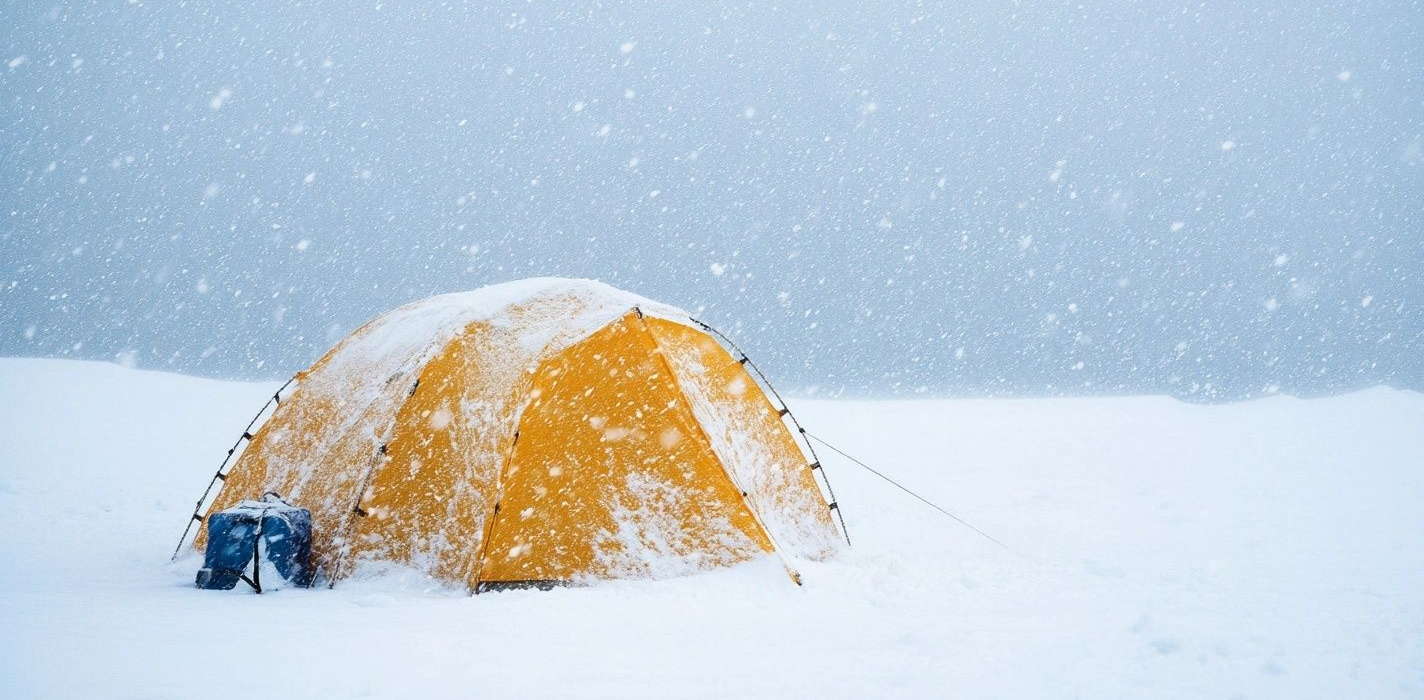
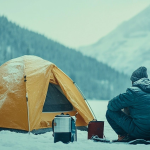
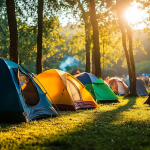
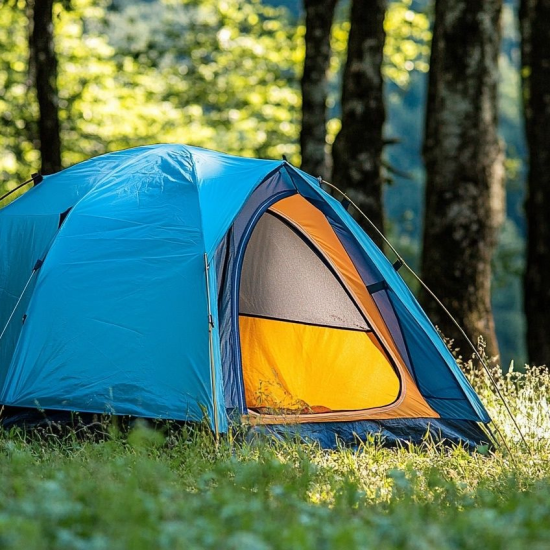
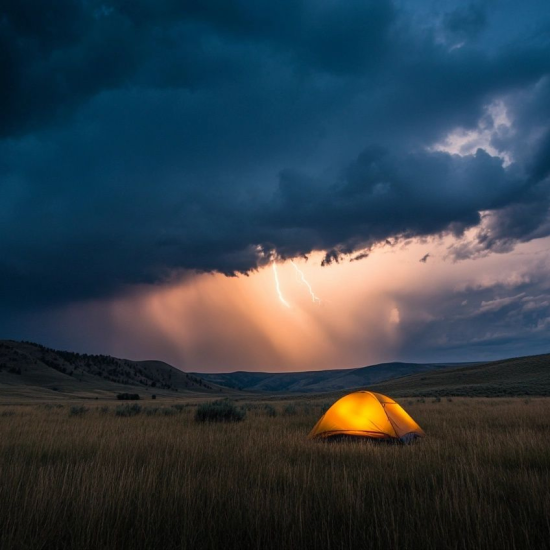
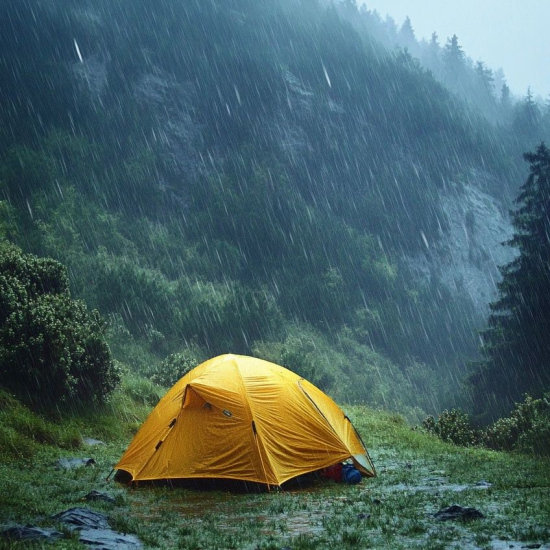
No Comment! Be the first one.